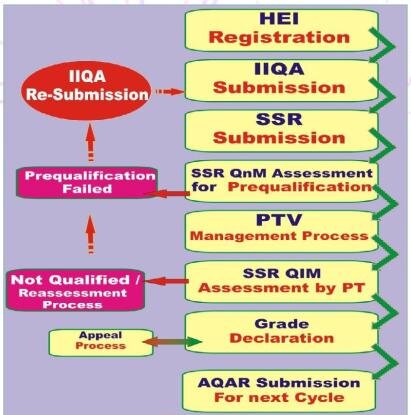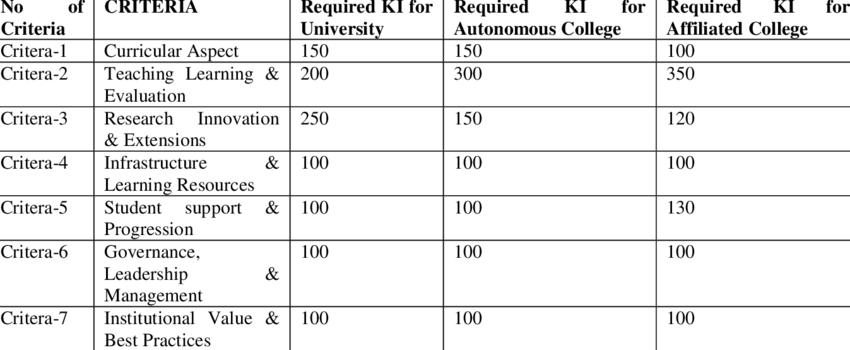The National Assessment and Accreditation Council (NAAC) has emerged as a significant landmark in the landscape of higher education in India. Established in 1994 by the University Grants Commission (UGC), the NAAC’s primary mandate is to evaluate and accredit higher education institutions (HEIs) across the country. With its headquarters in Bangalore, NAAC plays a pivotal role in enhancing the quality of education, promoting academic excellence, and fostering a culture of continuous improvement among institutions. The objective of this paper is to critically evaluate the impact of NAAC on HEIs in India while considering multiple perspectives on the effectiveness of the accreditation process, the challenges involved, and the broader implications for the educational ecosystem.
The Importance of Accreditation in Higher Education
Accreditation serves as a vital mechanism for ensuring quality standards in higher education. In the context of India, where over 1,000 universities and many more colleges exist, a robust accreditation system is essential for maintaining educational integrity and fostering public trust (NCRT, 2019). The NAAC’s accreditation process involves a comprehensive assessment based on a set of criteria that include curriculum design, teaching-learning methodologies, research initiatives, infrastructure, and student support services. This systematic evaluation ensures that institutions adhere to recognized standards of educational quality, which is crucial for enhancing the overall learning experience for students (Kumar & Agrawal, 2021).
Perspective of Educational Institutions

From the viewpoint of HEIs, accreditation by NAAC has both advantages and limitations. On one hand, institutions that achieve a high NAAC grade (A or above) gain a competitive edge in attracting students, faculty, and funding. The accreditation process provides institutions with a roadmap for self-improvement, facilitating refined governance and operational effectiveness. Institutions often need to engage in introspection and alignment of their strategic objectives with quality standards, fostering an environment of academic rigor (Pillai & Suresh, 2020).
However, some institutions criticize the NAAC’s metrics as being overly stringent and bureaucratic. Critics argue that the rigid frameworks established for evaluation may not adequately reflect the unique contexts and missions of diverse institutions, often leading to homogenization rather than innovation in educational practices. Furthermore, there are concerns about the adequacy of the NAAC’s criteria in addressing emergent challenges such as the integration of technology and the evolving job market demands (Rajasekaran, 2018). As such, HEIs sometimes feel restricted in their academic freedom and creative approaches to education.
Perspectives of Students and Stakeholders

Students, as the primary beneficiaries of the education system, have significant stakes in the accreditation process. From the consumer’s perspective, accredited institutions are perceived to offer higher quality education and better career prospects. The NAAC accreditation signals to students that the institution meets established quality benchmarks, thus aiding their decision-making processes regarding enrollment (Sharma & Singh, 2020). This sense of security has encouraged students to pursue higher education at accredited institutions, leading to an overall increase in enrollment rates in India.
In contrast, stakeholders such as employers and policymakers often express concerns regarding the efficacy and transparency of the NAAC accreditation process. While employers place significant trust in NAAC accreditation as a marker of quality, anomalies in the process may inadvertently dilute the meaning and value of the accreditation itself. An instance of this is when institutions engage in superficial adherence to metrics solely to achieve better grades rather than focusing on genuine enhancement in quality outputs. This raises questions about whether the current evaluation methods effectively measure an institution’s real-time impact on students and society (Varghese, 2021).
The Socioeconomic Impact of NAAC
The socioeconomic implications of NAAC’s accreditation process are profound. As HEIs transition toward greater accountability, there is increased emphasis on inclusivity and equitable access to educational opportunities. NAAC encourages institutions to adopt practices that promote diversity and support underprivileged groups, aligning with national policies aimed at social justice (Choudhury & Bhattacharya, 2021). The council’s framework-initiatives foster institutional commitment toward community engagement and sustainable development, which are critical for India’s socioeconomic progress.
However, the NAAC’s imperative to improve quality can inadvertently create disparities among institutions. While top-tier institutions benefit from a wealth of resources and funding, those in rural or economically disadvantaged areas may struggle to meet the same standards. This creates a dichotomy where elite institutions flourish while others lag behind, potentially exacerbating existing inequalities (Jain & Rahman, 2020). Addressing this imbalance will be fundamental to achieving a truly inclusive education system.
Conclusion
The National Assessment and Accreditation Council (NAAC) has undoubtedly played a transformative role in shaping the higher education landscape in India. Through its rigorous accreditation processes, it has successfully enhanced the quality of education and fostered a culture of continuous improvement among HEIs. However, this evaluation must recognize the diverse stakeholders – including educational institutions, students, employers, and policymakers – each of whom brings a unique perspective to the discussion. A balanced approach that acknowledges both the strengths and limitations of the NAAC framework is essential for promoting a quality-driven, inclusive education system that adequately prepares students for the challenges of the future. Future policy recommendations should prioritize refining the accreditation process to incorporate flexibility, inclusivity, and responsiveness to emerging educational trends.
References
- Choudhury, S., & Bhattacharya, S. (2021). The impact of accreditation on the quality of higher education in India. Journal of Educational Policy and Practice, 6(2), 95-110.
- Jain, P., & Rahman, F. (2020). Addressing disparities in higher education in India: A critical analysis of the NAAC accreditation process. International Journal of Educational Research and Review, 5(4), 419-425.
- Kumar, R., & Agrawal, M. (2021). Evaluation of the National Assessment and Accreditation Council: Issues and Recommendations. Indian Journal of Adult Education, 82(1), 42-58.
- Pillai, P., & Suresh, P. G. (2020). Strategic management practices and their role in the accreditation process: A study on institutions in India. Journal of Strategic Management, 5(3), 211-226.
- Rajasekaran, V. (2018). The role of NAAC in quality assurance in higher education: A critical review. Quality Assurance in Education, 26(1), 27-40.
- Sharma, S., & Singh, A. (2020). Assessing the impact of NAAC accreditation on student enrollment in higher education institutions. Educational Studies, 46(4), 420-435.
- Varghese, B. (2021). The road ahead for NAAC: Rethinking accreditation standards in Indian higher education. Indian Journal of Higher Education, 12(1), 78-89.
- NCRT. (2019). The state of higher education in India: A comprehensive report. National Council of Educational Research and Training. Retrieved from [NCRT website]